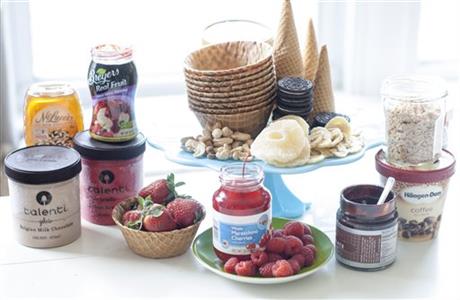
By MICHELE KAYAL
This Apr. 14, 2014 photo shows ice cream season supplies , from top left clockwise, ice cream waffle cones and bowls, oreos, assorted nuts, dried pineapple, granola, Haagen-Dazs ice cream, chocolate sauce, raspberries, maraschino cherries, strawberries and Talenti gelato, honey and Breyers real fruit topping in Concord, N.H. (AP Photo/Matthew Mead)
Food Ice Cream Season
This Apr. 14, 2014 photo shows ice cream season supplies , from top left clockwise, ice cream waffle cones and bowls, oreos, assorted nuts, dried pineapple, granola, Haagen-Dazs ice cream, chocolate sauce, raspberries, maraschino cherries, strawberries and Talenti gelato, honey and Breyers real fruit topping in Concord, N.H. (AP Photo/Matthew Mead)
Coming soon to a freezer aisle near you — balsamic vinegar ice cream. Plus, hot sauce ice cream. And maybe even tomato.
“You’re seeing the same kinds of trends in ice cream that you’re seeing in other foods,” says Peggy Armstrong, spokeswoman for the International Dairy Foods Association. “People are willing to experiment.”
Just a generation ago, Americans mostly bought their ice cream at the supermarket in recognizable flavors that occasionally sported chocolate chips or a swirl of some kind. Today, regular old ice cream has been joined by boutique items such as gelato, sorbet and water ice, as well as an army of flavors that seem more at home in an Italian restaurant — opal basil lemon sorbet, anyone? — than in your local freezer aisle.
Americans ate nearly 1.6 billion gallons of ice cream and other frozen dairy desserts in 2012. But traditional ice cream’s share of that market has been shrinking, edged out by specialty items such as frozen yogurt and gelato. In 2012, production of regular ice cream hit its lowest point since 1996, the Dairy Foods Association says, hitting fewer than 900 million gallons.
Boutique scoop shops and artisanal producers have flooded the landscape during the last five to 10 years, introducing audiences to a wider range of flavors and textures. Cumin and honey butterscotch, salty vanilla, and pumpernickel are typical of Jeni’s Splendid Ice Creams, an Ohio-based producer that has gone national. Uber-hip Coolhaus, which has parlayed ice cream trucks and storefronts into distribution in 2,000 supermarkets, offers Cuban cigar, spicy pineapple-cilantro and even fried chicken and waffle ice cream.
“The flavor we thought nobody would buy was balsamic fig mascarpone, and that’s the one we’re out of,” says Coolhaus co-founder Natasha Case about the company’s recent experience at a trade show. “All the buyers want that one. Two years ago, we were out of vanilla. That buyer at that show who does five to 300 grocery chains wants to know what’s cool, whereas before they just wanted to know that you could do vanilla well.”
Vanilla remains supreme, Armstrong says, but the mass-market producers represented by her organization are branching out. At the association’s annual ice cream technology conference in April, producers showcased flavors such as Mexican-spiced chocolate and hot sauce ice cream. Ice cream flavors such as caramel popcorn, coffee-and-doughnuts, cotton candy and peanut butter s’mores also are destined for supermarket shelves.
Though we are in an intense period of flavor experimentation, the desire to go beyond chocolate, vanilla and strawberry dates to the post-World War II era, says Laura B. Weiss, author of “Ice Cream: A Global History.” That’s when Howard Johnson, known for his roadside restaurants, tried to convince Americans to indulge in his famous 28 flavors. Among them: maple walnut, burgundy cherry and fruit salad.
“This was really pretty revolutionary,” Weiss says. “Going beyond chocolate, vanilla and strawberry really began with Howard Johnson.”
Even today’s most exotic-sounding new flavors make sense on some level. Candied sweet potato, a flavor being explored by Parker Products in Ft. Worth, Texas, has its roots in Southern sweet potato pie. Ice cream behemoth Haagen-Dazs recently launched tomato ice cream in Japan, as well as a carrot-orange flavor. And why not, says Jeni Britton Bauer of Jeni’s Splendid Ice Creams.
“A lot of vegetables have a very sweet flavor,” she says. “Like corn. Even when you make it salty, it’s still sweet and milky.”
Producers also are tackling whiskey, beer and other alcohols in new ways. Jeni’s Splendid makes a cherrywood smoked porter ice cream studded with rosemary-sprinkled bar nuts. High Road Craft Ice Cream in Marietta, Georgia, makes a bourbon-burnt sugar flavor. “Ice cream is a great canvas for evoking those flavors and speaking to those profiles, but also having fun with the cocktails, the old fashioneds and the Manhattans,” says Coolhaus’ Case. “And I don’t have to card people. It’s a food.”
The next revolution, ice cream watchers say, will be in creating more texturally sophisticated ice creams. Customers are beginning to demand smoother, creamier products that suggest the hand of the artisan.
“Just in the way that people have learned to crave sophisticated flavors, they now want textures where the mouth-feel is really rich and delicious,” Weiss says. “The next thing is texture. It can be a fabulous flavor, but if it doesn’t feel really smooth and creamy and rich, it loses something.”



